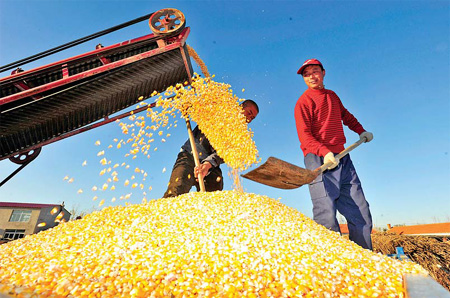Chinese grain harvest rises for the eighth consecutive year
Updated: 2011-12-03 08:03
By Zhou Siyu (China Daily)
|
|||||||||
|
Farmers in Shenyang, Liaoning province, with the corn they harvested in October. Food production has risen to a record high of 571 million tons this year, registering an increase of 4.5 percent year-on-year. Zhang Wenkui / for China Daily |

Food output rose to a record 571 million tons
BEIJING - China achieved another bumper agricultural harvest this year, the eighth consecutive year of growth for grain output and a record for food production, said the National Bureau of Statistics in a statement released on Friday.
Agricultural experts said the bumper harvest will help ease the country's food price hikes, facilitating the government's efforts to combat the stubbornly high inflation rate.
But the experts also said that China's robust demand means the increased grain production is unlikely to check the country's growing imports, particularly for corn.
Bumper yields this year saw food output rising to a record 571 million tons, registering a 4.5 percent increase year-on-year. The production volume has already reached the government's grain output target for 2020, the bureau said.
Yields of the three major crops - rice, wheat and corn - stood at 510 million tons. Rice output increased by 2.6 percent year-on-year to 200 million tons, wheat grew by 2.4 percent year-on-year to 118 million tons, while corn jumped by 8.2 percent from last year to 192 million tons, according to official data.
Increased corn yields reflected an improvement in the country's grain-production structure, the statistics bureau said.
"The increased food production will help stabilize the prices of agricultural commodities and ease the government's effort to contain the inflation rate next year," said Hu Bingchuan, a researcher at the Rural Development Institute of the Chinese Academy of Social Sciences.
Since the beginning of the year, the government has prioritized efforts to combat high inflation. In July, the consumer price index (CPI), the major gauge of inflation, surged to a 37-month high of 6.5 percent year-on-year.
It declined to 5.5 percent in October and is expected to continue its downward trend, when figures for November are released. Food prices, especially the increased price of pork, were regarded as one of the major drivers of the surging inflation.
As the country's urbanization process deepened, Chinese families consumed more meat in their daily diet, generating extra demand for corn as animal feed.
In the meantime, industrial demand for starch and ethanol also increased, imposing upward pressure on corn imports.
Prompted by the surging demand, corn imports this year are still expected to grow, despite increased domestic production, said Ma Wenfeng, a senior analyst at Beijing Orient Agribusiness Consultant Ltd, a major agricultural consultancy.
In October, Morgan Stanley issued a report saying China is expected to import 4 million tons of corn this year, compared with last year's 1.57 million tons.
However according to Ma, the increase is unlikely to be that drastic. "I reckon this year's corn imports are likely to stand between 2 million tons and 2.5 million tons," Ma said.
Corn imports are expected to maintain a "mild and stable increase" over the next few years, said Xu Xiaoqing, director of the department for rural economic development at the Development Research Center of the State Council, one of China's top think tanks.
The country imported 645,000 tons of corn during the first nine months of this year, according to data from grain.gov.cn, a website operated by the China National Grain and Oils Information Center.
In July, China ordered 533,000 tons of corn for delivery after August from the United States, according to the US Department of Agriculture, exceeding US estimates for Chinese's corn imports for the whole year.
China Daily
(China Daily 12/03/2011 page9)












